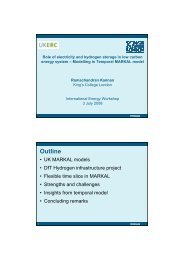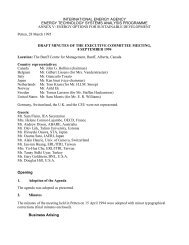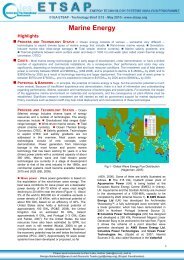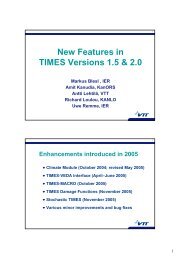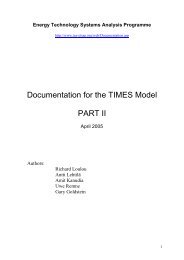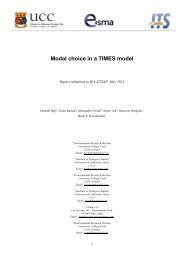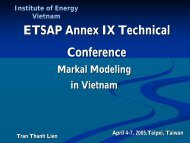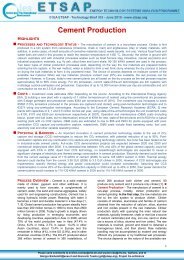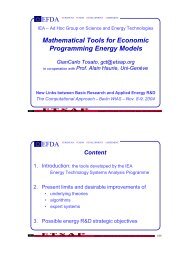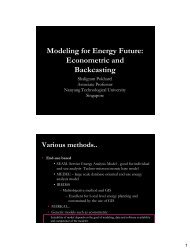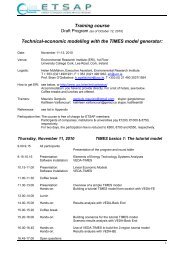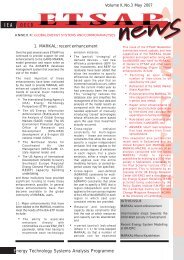Documentation for the MARKAL Family of Models - iea-etsap
Documentation for the MARKAL Family of Models - iea-etsap
Documentation for the MARKAL Family of Models - iea-etsap
You also want an ePaper? Increase the reach of your titles
YUMPU automatically turns print PDFs into web optimized ePapers that Google loves.
3. Concepts and Theory<br />
3.1 Introduction<br />
<strong>MARKAL</strong>-MACRO (Manne and Wene, 1992) is <strong>the</strong> result <strong>of</strong> merging two existing<br />
model approaches into a single, self-contained new model. On <strong>the</strong> one hand, <strong>the</strong>re is <strong>the</strong><br />
<strong>MARKAL</strong> model (see PART I), with its detailed, explicit technological representation.<br />
On <strong>the</strong> o<strong>the</strong>r hand, <strong>the</strong>re is MACRO (Manne and Richels, 1992), a succinct, single sector,<br />
optimal growth dynamic inter-temporal general equilibrium model, based on <strong>the</strong><br />
maximization <strong>of</strong> a national utility function. Merging <strong>the</strong>se two models results in a new<br />
model that captures <strong>the</strong> characteristics <strong>of</strong> an intertemporal general equilibrium model,<br />
while retaining <strong>the</strong> rich technological detail <strong>of</strong> <strong>MARKAL</strong>. The equilibrium is based on<br />
<strong>the</strong> assumption <strong>of</strong> perfect <strong>for</strong>esight and competitive markets, in <strong>the</strong> sense <strong>of</strong> neo-classical<br />
economic <strong>the</strong>ory. The economic agents in <strong>MARKAL</strong>-MACRO are: <strong>the</strong> generic suppliers<br />
and consumers <strong>of</strong> energy (as in <strong>MARKAL</strong>), plus <strong>the</strong> o<strong>the</strong>r suppliers <strong>of</strong> goods and<br />
services (regrouped into a single representative producing sector), <strong>the</strong> consumers<br />
(regrouped into a single generic consumer), and a simplified, generic capital market.<br />
Government is not represented as such in <strong>MARKAL</strong>-MACRO. Export markets may be<br />
represented if a multi-regional <strong>MARKAL</strong>-MACRO model is constructed.<br />
A precursor <strong>of</strong> this approach is ETA-MACRO (Manne and Richels 1992), where <strong>the</strong><br />
ETA module was however a less detailed energy supply module than <strong>MARKAL</strong> is. ETA-<br />
MACRO was subsequently used as a component <strong>of</strong> <strong>the</strong> MERGE model (Manne et al.<br />
1995), a global multi-regional G.E. model with emphasis on modeling global emissions<br />
and concentrations <strong>of</strong> Greenhouse Gases.<br />
The linkage between <strong>MARKAL</strong> and MACRO is done at <strong>the</strong> level <strong>of</strong> demands <strong>for</strong> energy<br />
services. In <strong>MARKAL</strong> <strong>the</strong>se demands are specified exogenously in <strong>the</strong> reference case,<br />
and are <strong>the</strong>n endogenously altered by <strong>the</strong> model <strong>for</strong> alternate scenarios, as long as ownprice<br />
elasticities <strong>for</strong> <strong>the</strong> energy service demands are specified by <strong>the</strong> user. In <strong>MARKAL</strong>-<br />
MACRO, a different approach is used: <strong>the</strong> demands are variables <strong>of</strong> <strong>the</strong> model that are<br />
aggregated to become <strong>the</strong> Energy input into <strong>the</strong> MACRO production function, alongside<br />
Labor and Capital. Figure 3-1 shows <strong>the</strong> links between <strong>the</strong> <strong>MARKAL</strong> and MACRO<br />
modules <strong>of</strong> <strong>the</strong> new model. The solid lines indicate physical flows, whereas <strong>the</strong> dashed<br />
lines indicate monetary flows. The <strong>MARKAL</strong> module thus provides one physical input to<br />
<strong>the</strong> MACRO module (aggregate energy), and <strong>the</strong> MACRO module provides one<br />
monetary input to <strong>the</strong> <strong>MARKAL</strong> module (energy cost).<br />
We now provide a full <strong>for</strong>mulation <strong>of</strong> <strong>the</strong> model. Much <strong>of</strong> <strong>the</strong> material in this chapter is<br />
taken from Manne and Wene (1992), which provides additional detail to <strong>the</strong> interested<br />
reader.<br />
389



